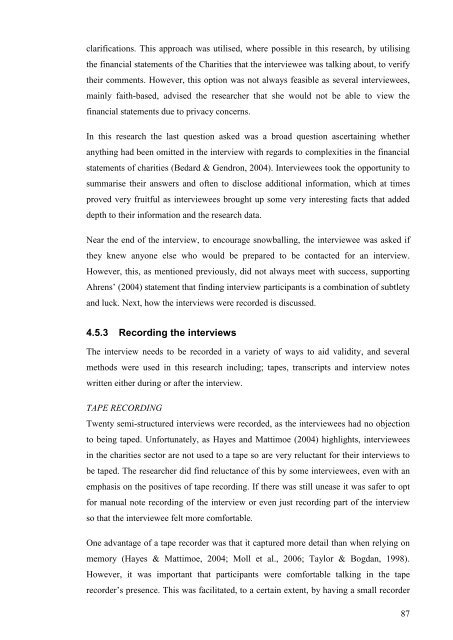Understandability and Transparency of the Financial Statements of ...
Understandability and Transparency of the Financial Statements of ...
Understandability and Transparency of the Financial Statements of ...
You also want an ePaper? Increase the reach of your titles
YUMPU automatically turns print PDFs into web optimized ePapers that Google loves.
clarifications. This approach was utilised, where possible in this research, by utilising<br />
<strong>the</strong> financial statements <strong>of</strong> <strong>the</strong> Charities that <strong>the</strong> interviewee was talking about, to verify<br />
<strong>the</strong>ir comments. However, this option was not always feasible as several interviewees,<br />
mainly faith-based, advised <strong>the</strong> researcher that she would not be able to view <strong>the</strong><br />
financial statements due to privacy concerns.<br />
In this research <strong>the</strong> last question asked was a broad question ascertaining whe<strong>the</strong>r<br />
anything had been omitted in <strong>the</strong> interview with regards to complexities in <strong>the</strong> financial<br />
statements <strong>of</strong> charities (Bedard & Gendron, 2004). Interviewees took <strong>the</strong> opportunity to<br />
summarise <strong>the</strong>ir answers <strong>and</strong> <strong>of</strong>ten to disclose additional information, which at times<br />
proved very fruitful as interviewees brought up some very interesting facts that added<br />
depth to <strong>the</strong>ir information <strong>and</strong> <strong>the</strong> research data.<br />
Near <strong>the</strong> end <strong>of</strong> <strong>the</strong> interview, to encourage snowballing, <strong>the</strong> interviewee was asked if<br />
<strong>the</strong>y knew anyone else who would be prepared to be contacted for an interview.<br />
However, this, as mentioned previously, did not always meet with success, supporting<br />
Ahrens‟ (2004) statement that finding interview participants is a combination <strong>of</strong> subtlety<br />
<strong>and</strong> luck. Next, how <strong>the</strong> interviews were recorded is discussed.<br />
4.5.3 Recording <strong>the</strong> interviews<br />
The interview needs to be recorded in a variety <strong>of</strong> ways to aid validity, <strong>and</strong> several<br />
methods were used in this research including; tapes, transcripts <strong>and</strong> interview notes<br />
written ei<strong>the</strong>r during or after <strong>the</strong> interview.<br />
TAPE RECORDING<br />
Twenty semi-structured interviews were recorded, as <strong>the</strong> interviewees had no objection<br />
to being taped. Unfortunately, as Hayes <strong>and</strong> Mattimoe (2004) highlights, interviewees<br />
in <strong>the</strong> charities sector are not used to a tape so are very reluctant for <strong>the</strong>ir interviews to<br />
be taped. The researcher did find reluctance <strong>of</strong> this by some interviewees, even with an<br />
emphasis on <strong>the</strong> positives <strong>of</strong> tape recording. If <strong>the</strong>re was still unease it was safer to opt<br />
for manual note recording <strong>of</strong> <strong>the</strong> interview or even just recording part <strong>of</strong> <strong>the</strong> interview<br />
so that <strong>the</strong> interviewee felt more comfortable.<br />
One advantage <strong>of</strong> a tape recorder was that it captured more detail than when relying on<br />
memory (Hayes & Mattimoe, 2004; Moll et al., 2006; Taylor & Bogdan, 1998).<br />
However, it was important that participants were comfortable talking in <strong>the</strong> tape<br />
recorder‟s presence. This was facilitated, to a certain extent, by having a small recorder<br />
87

















